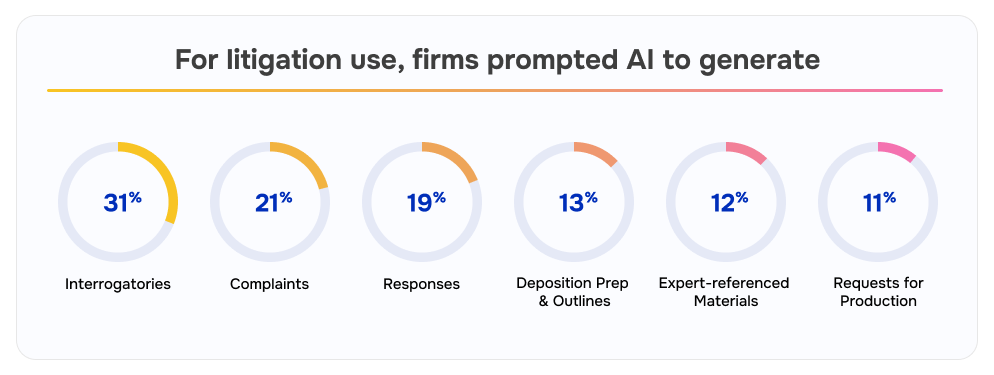Litigation Stands as One of the Most Demanding and High-Stakes Arenas within Personal Injury Law
Every motion, interrogatory, and deposition outline must be meticulously crafted, grounded in evidence, and delivered under tight deadlines.
In response to these intense demands, law firms are increasingly leveraging legal AI for support. By analyzing thousands of litigation-specific prompts, we’ve seen a clear pattern for how attorneys use AI to accelerate drafting, sharpen arguments, and unearth crucial facts buried in case files. Here are our litigation-specific findings.
AI Prompts: The Backbone of Modern Litigation
Among litigation-focused prompts in AI Drafts™, document generation and drafting account for 71% of AI use. Document creation is where litigation teams are seeing the most impact from AI.
Piai™ acts as a powerful ally, augmenting attorneys’ and paralegals’ capabilities by expediting drafting and distilling vast information into actionable insights. Piai™ enhances, but does not replace, the human element of legal judgment and advocacy, but rather gets you closer to a final draft than anything else on the market.
EvenUp is an absolutely spectacular and multifaceted tool to help with all aspects of litigation. I’ve used it to answer routine and more complicated interrogatories, analyze medical treatment, and identify discrepancies in deposition testimony. The most beneficial aspect is the detailed analysis of medical treatment, diagnosis, medical timeline, and medical document review.”
Alex Y. Kaplan
Founder and Attorney
Kaplan Law offices, P.C.
Boosting Litigation Prowess EvenUp’s Legal AI Assistant, Case Companion™
From all our analysis, the most effective litigation prompts share a few common traits: they’re focused, fact-driven, and tied to the core elements of a case.
From claim evaluation to trial prep, here’s what works best:
1. Start with the Elements of the Claim
The strongest prompts map directly to duty, breach, causation, and damages. Instead of asking broad questions, litigation attorneys prompt Case Companion™ to surface the specific facts that establish or undermine each element.
2. Use Prompts to Audit the Record
Many high-impact prompts are less about drafting and more about validating completeness; spotting missing documents, unsupported allegations, or vague responses.
3. Prep Strategically for Depositions and Motions
Deposition prompts often focus on surfacing contradictions, pulling direct quotes, and curating exhibits; turning raw discovery into cross-examination material. Motion-related prompts map facts directly to standards for summary judgment or motions in limine.
Takeaway for Litigation Teams
The common thread across litigation prompting is structure. The best prompts mirror how attorneys already think; tying facts to elements, timelines, and standards.
By prompting with precision, litigators transform Case Companion™ into a strategic partner that accelerates claim evaluation, strengthens pleadings, audits discovery, and sharpens trial prep.
Litigation Is No Place for General AI
Litigation documents, such as interrogatories, complaints, and deposition outlines, aren’t just about filling in templates; they require precise facts tailored to the case record. These are high-stakes court-submitted documents. And with the prevalence of AI adopters and detractors, all eyes are on documents for AI hallucinations and other mistakes.
That’s why litigation teams must have specialized, task-oriented AI models, such as EvenUp. With EvenUp, everything runs through Piai™; our collection of purpose-built vertical AI models that are specifically built for the nuance of personal injury. This ensures that any references in generated content or insights gleaned from case analysis are rooted in the facts of the case as presented by the case files and linked back to the exact citation(s) within the file being referenced.
Because it works directly from synced case files; medical records, billing summaries, prior correspondence, discovery responses; Piai™ can pull answers, dates, and details without making you dig through files or go back to the client for information they’ve already provided, with just a few prompts.
Trial-Ready Documents With Less Trial-and-Error
Litigation success depends on precision and preparation.
With Case Companion™, litigators can evaluate claims, refine pleadings, strengthen discovery practice, and prepare for trial in a fraction of the time. And because every output is linked back to the underlying record through Piai™, attorneys can trust that the facts are accurate, cited, and ready for court.





